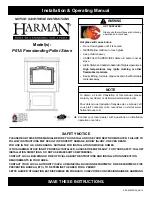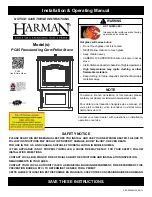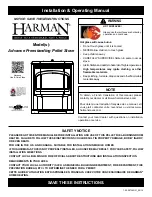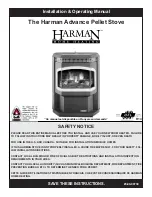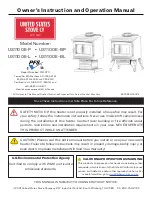
Use and maintenance manual for stoves with RDS technology
Pag.12
Rev.0 05/12/2022
Mobile Home Requirements
- Outside air is required
- The heater must be secured to the floor using lag bolts.
- The heater must be grounded to the chassis of the mobile home.
- Installation should be in accordance with the manufactured home.
- When outside air is required, system parts, such as vent sections, supports, spark arresters, rodent screens, etc. must be used.
- The space heater is to be connected to a type L pellet vent conforming to CAN/ULC S609 or UL641.
- Installation shall maintain an effective vapour barrier at the location where the chimney or other component penetrates to the exterior
of the structure.
- Operating the space heater with open firing doors can cause serious injuries and health damages due to excaping flames or carbon
monoxide generation inside the room.
- Adequate ventilation is required to avoid air starvation and icing which can determine an unhealthy indoor environment.
- Do not overfire.
- If the space heater is not correctly installed and operated it can interfere with smoke detectors.
- Where the space heater is installed in a transportable building, removal of the chimney for transportation of the building.
⚠
Do not install in bedroom
⚠
The structural integrity of the mobile home floor, ceiling, walls, roof must be maintained.
⚠
Refer to HUD Requirements, CFR 3280, Part 24
📌
Install vent at clearances specified by the vent manufactures.
📌
Measure clearances to the nearest edge of the exhaust hood.
📌
Vent may not terminate in covered walkway or breezeway.
📌
If venting horizontally, check your venting specifications for distance pipe should extrude from building.
Vent Termination Locations
A) Minimum 4’ clearance below or beside any door or window that opens (with outside air installed, 1’ below or beside)
Minimum 1’ clearance below or beside any window that does not open.
B) Minimum 1’ clearance above any door or window that opens
C) Minimum 2’ clearance from any adjacent building
D) Minimum 7’ clearance above any grade when adjacent to public walkways
E) Minimum 2’ clearance above any grass, plants, or other combustible materials
F) Minimum 3’ clearance from any forced air intake of any other appliance
G) Minimum 2’ clearance below eaves or overhangs
H) Minimum 1’ clearance horizontally from combustible wall
X) Must be a minimum of 2’ above the roof ridge
User and maintenance manual for stoves with RDS technolo
gy
Pag.8
11/11/14
6.2 Environment of use
The positioning of the stove is decisive for successful even heating of the room. Before deciding where to place the stove, the following must be
taken into account:
- The stove must be installed on a floor with a sufficient carrying capacity. If the existing building does not meet this requisite, appropriate measures
must be taken (i.e. load distribution plate).
- The combustion air cannot be obtained from a garage or from an area without ventilation or exchange of air, but from a free or external space
- The stove must not be installed in a bedroom, bathroom or shower, or where there is already another heating appliance without an autonomous
air flow (chimney, stove etc.)
- A minimum of 3” inches from the rear of the stove, 3” inches from the side of the stove and 16” inches from the top of the stove must be maintained
from combustible materials.
- A non-combustable Hearth board 6” from front of unit and 6” from the sides must be installed before unit is placed on the floor.
- Installation is better in a large and central room in the house to ensure maximum circulation of the heat;
- Connection to the main supply is recommended using a grounded outlet (if the cable supplied is not long enough to reach the nearest outlet, use
an extension cord with a surge protector);
- The stove must be placed in a position that receives the necessary level of air for appropriate combustion of the pellets (at least 131.23 f
3
/h must
be available), in accordance with installation regulation and local legislations;
- All joints for connector pipe is required to be fastened with at least three screws.
- If vented horizontally joint should be siliconed with hi-temp. silicone and screwed so they are gas tight. (R
TU 500 silicone)
- the chimney connector shall not pass through an attic or roof space, closet or similar conceald space, or a floor or ceiling. Where passage through
a wal, or partition of combustible construction is desired, the installationshall conform to CAN/CSA-B365.
The stove must be installed and assembled by qualified personnel.
The room must be:
- Prepared for the environmental functioning conditions
- Prepared with an adequate system of evacuation of smoke
- Have a 120V 60 Hz (EN73-23) electricity mains supply
- Do not connect this unit to a chimney flue serving another appliance
- Use only UL Listed Type L Vent or Pellet Vent 3” in. I.D. venting system to exhaust. Do not install flue damper in the exhaust system of this unit.
- The chimney connector and each other adjoining section must be firmly attached and secured to the stove.
6.3 Mobile Home Requirements
- Outside air is required
- The heater must be secured to the floor using lag bolts.
- The heater must be grounded to the chassis of the mobile home.
-
Installation should be in accordance with the manufactured home.
- When outside air is required, system parts, such as vent sections, supports, spark arresters, rodent screens, etc. must be used.
- The space heater is to be connected to a factory built chimney conforming to CAN/ULC-S629.
- It is important to use all the specified components, do not use other components.
- Installation shall maintain an effective vapour barrier at the location where the chimney or other component penetrates to the exterior of the
structure.
-Operating the space heater with open firing doors can cause serious injuries and health damages due to excaping flames or carbon monoxide
generation inside the room.
- Adequate ventilation is required to avoid air starvation and icing which can determine an unhealthy indoor environment.
- Do not overfire.
- If the space heater is not correctly installed and operated it can interfere with smoke detectors.
A
Minimum 4’ clearance below or beside any door or window that opens
Minimum 1’ clearance below or beside any window that does not open.
B
Minimum 1’ clearance above any door or window that opens
C
Minimum 2’ clearance from any adjacent building
D
Minimum 7’ clearance above any grade when adjacent to public walkways
E
Minimum 2’ clearance above any grass, plants, or other combustible materials
F
Minimum 3’ clearance from any forced air intake of any other appliance
G
Minimum 2’ clearance below eaves or overhangs
H
Minimum 1’ clearance horizontally from combustible wall
X
Must be a minimum of 2’ above the roof
WARNING: Do not install in bedroom
CAUTION: The structural integrity of the mobile home floor,
ceiling, walls, roof must be maintained.
Refer to HUD Requirements, CFR 3280, Part 24
NOTE:
Install vent at clearances specified by the vent
manufactures.
NOTE:
Measure clearances to the nearest edge of the exhaust
hood.
NOTE:
Vent may not terminate in covered walkway or breezeway.
NOTE:
If venting horizontally, check your venting specifications for
distance pipe should extrude from building.





























